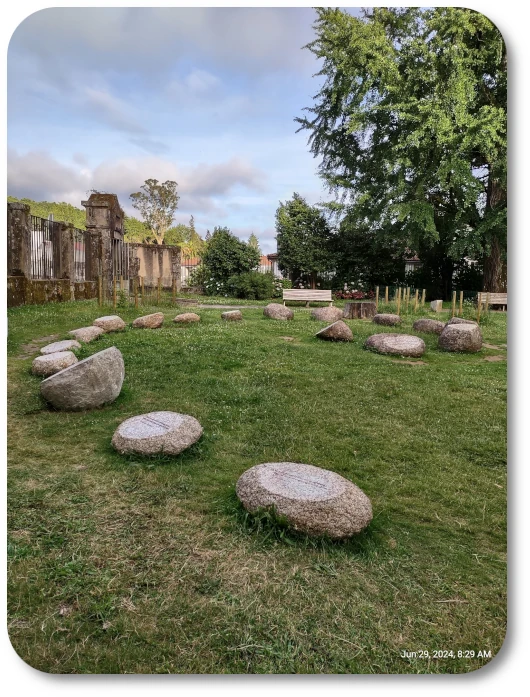- Rosary
- spiritual meditation
- Contemplative Arts
Contemplative Arts
Introduction

The phrase Contemplative Arts carries a sense of stillness, creativity, and prayer woven together. These arts are not about performance or display but about entering a deeper space within the soul.
They allow the heart to slow down, to listen, and to receive what ordinary noise often covers. In the quiet of contemplation, the smallest act — arranging a stone, tracing a line, or simply pausing to breathe — becomes an offering.
Here at Santiago de Compostela, a place known for pilgrimage and prayer, the Circle of Stones was created as a quiet garden of reflection. Each stone bears a unique mark or phrase, placed not to decorate but to draw the mind inward.
Walking among them is like following a path of silent prayer, where every turn invites the heart to discover something new. The contemplative arts invite the pilgrim to walk not only through the garden but through their own inner landscape.
Contemplative arts encompass practices that foster deep reflection, mindfulness, and a connection to the present moment.
Circle of Stones
Meditation Garden
As visitors or pilgrims enter the Circle of Stones Meditation Garden, they are greeted by the calming sounds of nature. The gentle rustling of leaves and the soft chirping of birds create an atmosphere conducive to contemplation.
Each stone serves as an invitation to pause and reflect on the deeper meanings of life, identity, and connection.
Engaging with the Poems
The multilingual poems offer travelers a unique opportunity to engage with different cultures and perspectives.
Reading each poem allows pilgrims to explore the universal themes of truth, silence and self-discovery, fostering a sense of shared humanity.
Community and Connection
The garden is not just a space for individual reflection; it also serves as a gathering place for the community. Workshops, meditation sessions, and cultural events are often held here, promoting dialogue and understanding among diverse groups of people.
What Are Contemplative Arts?
Contemplative arts are practices that slow us down enough to notice. They can take many forms: silence, poetry, song, or even the simple act of noticing light falling through a window. Unlike traditional arts that strive for beauty on the surface, contemplative arts move deeper. Their beauty lies in the way they stir the heart toward God and open space for peace.
Here, the stones of Santiago invite this practice. Each one carries its own voice, though spoken quietly. To stand before them is to be reminded that meaning is not always loud or obvious. Sometimes the most powerful truths arrive like a whisper. This garden teaches that prayer is not only words but presence. Simply standing among these stones is already a prayer of stillness, a prayer of being.
Walking Among the Stones
Each stone bears an image or phrase, waiting to be discovered. When approached with the eyes of contemplation, the stones become mirrors for the soul.
- Line of the Heart: A reminder that every prayer flows first from within. This stone invites the pilgrim to notice where their heart is leading and to follow that line faithfully.
- Stone in the Garden: A symbol of solitude, like Jesus praying in Gethsemane. It encourages the soul to remain steady even in the midst of struggle.
- Pinecone Heart: A natural image of fruitfulness and hidden seeds. Contemplation helps us see that small beginnings can grow into abundant grace.
- The Last Night: A stone that whispers of endings and quiet surrender. It teaches that even in the dark, God’s presence is near.
Other stones carry inscriptions that speak of trust, longing, silence, or watchfulness. To walk among them is to be reminded that life itself is made of many seasons, and each season carries a lesson for the heart.
🌱 Take a slow breath. Imagine yourself walking in this garden of stones. Which one calls to you today? Let it rest in your heart as a gentle prayer. In the quiet of the contemplative arts, every small step becomes a sacred offering.
The Mystery Stones
Two of the stones remain without clear interpretation. At first, this may feel incomplete, but in truth, it is a gift. The mystery stones teach that not everything needs explanation. Some truths are meant to be lived rather than understood.
Mystery humbles the mind and quiets the need for control. In prayer, there are moments when words fail. Silence then becomes the truest prayer. These stones invite us to stand still, to admit that we do not know everything, and to allow God to speak in His own time. In this way, even the unmarked stones become guides into deeper contemplation.